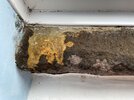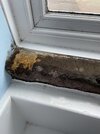We have several windows with mould around the limestone windows. This is worst:
We've used biocide to kill the mould and are sorting out ventilation.
However it is very unsightly and I cannot know when new mould is reappearing. A lot of anti-mould products that contain bleaching agents state they cannot be used on limestone, as it will react. Same would be true for any acid - e.g. vinegar.
Is there either something that can be safely used on limestone that will clean/restore back to (mostly) normal colour, or can I ignore the warning re bleach? e.g. it will damage the underlying surface, but this limestone isn't well finished anyway - not like smooth tiles for instance.
If I can get it cleaned up - I'm not too whether there is a recommended sealant/preventative stuff I can put down. I've read that mould can/will just grow underneath it?
Thanks in advance,
Steve
We've used biocide to kill the mould and are sorting out ventilation.
However it is very unsightly and I cannot know when new mould is reappearing. A lot of anti-mould products that contain bleaching agents state they cannot be used on limestone, as it will react. Same would be true for any acid - e.g. vinegar.
Is there either something that can be safely used on limestone that will clean/restore back to (mostly) normal colour, or can I ignore the warning re bleach? e.g. it will damage the underlying surface, but this limestone isn't well finished anyway - not like smooth tiles for instance.
If I can get it cleaned up - I'm not too whether there is a recommended sealant/preventative stuff I can put down. I've read that mould can/will just grow underneath it?
Thanks in advance,
Steve




